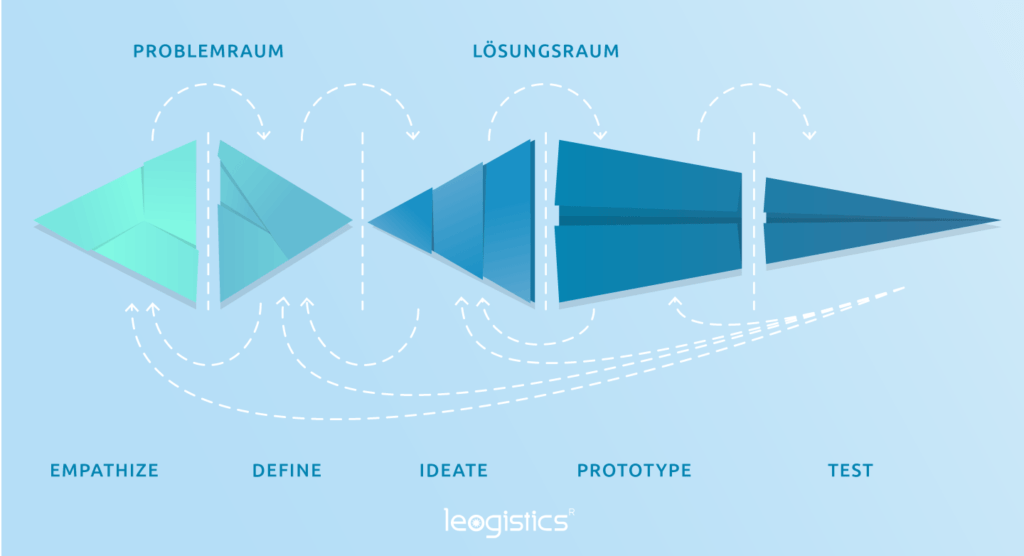Design thinking in development and implementation projects.
Design Thinking has established itself as a buzzword over many years. It is mostly used in connection with innovation processes in B2C industries. A cynic might claim that only B2Cers have the time for excessive creative processes, while in B2B solutions need to be found quickly. However, Design Thinking is much more than just a set of methods for creativity.
Through established techniques and procedures, Design Thinking enables a deep user understanding which in turn leads to maximum effectiveness of solutions. Hence, it is worth it! From there, this article will address the following topics: What is Design Thinking? How can software development and IT projects benefit from Design Thinking? And finally, what challenges occur in practice?
User centricity in it project environment
A product implemented by a customer, e.g. a software solution, is based on previously defined specifications and requirements at the beginning which should be adapted to the needs of the user, eventually. In fact, end users are rarely involved in the creation of specifications which not only results in time-consuming adjustments but also increases the required training effort. This leads to higher costs for the customer in the later course of the project and change requests become necessary.
User focus
Therefore, a user-centric development is crucial and provides the basis for targeted software solutions. If the user is optimally supported in the workflow, it positively affects the user’s planning and operative activities within the logistics process.
Design Thinking enables this kind of user involvement at a very early stage and requires timely planning of different design methods during the implementation phase.
Background: What exactly is design thinking?
What has already become clear so far: In Design Thinking, the user’s perspective represents the focus of every process. The term belongs to a set of working methods of a so-called “Designer Toolkit”. Design Thinking is by no means a fad of recent years but was shaped by the design and innovation agency IDEO as early as 1990 and established in Germany from 2007 through the further development of the Hasso Plattner Institute through the “School of Design Thinking”.
Design thinking in five steps
The ideal sequence of a design thinking process follows five steps, each of which contains different methods:
| 1. Empathize | Researching and creating awareness |
| 2. Define | Concretise findings and prioritise one challenge. |
| 3. Ideate | Develop a multitude of possible solutions and finally focus on one of them. |
| 4. Prototype | Develop a testable, simple version of the solution (e.g. Click-Dummies for Apps). |
| 5. Test | Verification of the actual relevance and function of the solution. |

In design thinking, two main spaces are differentiated. First, there is a problem space in which a challenge is defined, and findings are collected (see step one and two). Second, there is a solution space in which approaches to solve the identified problems are provided and tested (see third to fifth step). All steps can be repeated as needed until the challenge is overcome.
Design thinking in real life
The approach of design thinking is generally suitable for every new development or revision of a product, service or process – and increases their sustainability. The “right start” is crucial for long-term success of a novelty. Our experience proves: All too often, after a short discussion, you reach to solution proposals quickly (e.g. the use of new software), although you have not yet understood the core problem sufficiently. From our point of view, the essential first step of design thinking is often neglected, especially in B2B. That is where we want to change the process! Empathy! We observe and ask customers why something should change.
Observing “User Experience Test” serves as a practical example. There are many levers for more efficiency if you go beyond asking questions and additionally observe your end users using their existing solutions and draw conclusions from it.
- Where do users click?
- Where do delays occur?
- What works smoothly?
- What is the impact for the design of the solution or the product?
Example: mobile applications
In software development, we always focus on the end user: It starts with a Responsive UI and continues to advisory recommendations for end devices that meet all user requirements. Responsive UIs enable the user to use the software on different end devices and thus work location-independently.
We already check software requirements and the user’s working situation during the empathy phase: If the user works with gloves or if the working environment is influenced by factors such as brightness, temperature or dirt, this information can be taken into account at the beginning of the development process already. For example, the use of a classic desktop PC or touch device is sometimes not even possible, which is why leogistics is working on alternative user- and process-oriented software products.
How do you use design thinking in development and optimization projects?
It’s simple! And it´s fast! Design Thinking approaches can be integrated into almost every development and optimization process:
- We recommend a three-day Ideas Sprint for new developments that require many different solutions. After a preliminary user analysis, you will develop multiple ideas on the first day using creative techniques. On the second day, you create simple prototypes for a shortlist of the best solutions, including a detailed concept description and visualization. Day three concludes with a target group test. The Ideas Sprint provides high speed and a maximum of different solutions.
- To develop a concrete, technical solution or prototype, we recommend a four- to five-day design sprint. The focus remains the same: speed and truth. The first day is all about defining the right goals, the target group and their most important adjustment screws – empathy. In contrast to the Ideas Sprint, the following elaboration phase is more in-depth. The goal is the live test of a prototype that is as realistic as possible. In the end, you know exactly whether adjustments are still needed and make sure that your project budget is used in the best way possible.
The integration of design thinking methods into development or optimization projects enables fast and well working solutions to actual core challenges. Even if a logical solution accelerates your processes at first sight, it does not necessarily have to be the right and optimal solution. Methods from Design Thinking ensure the best possible “hit rate” for solving your individual challenges, while putting the end user in focus.
Final remark - what is your use case?
Design Thinking is part of many approaches when only one or two creative techniques are used.
In addition, many established design thinking theorists are not ideal guides to practical processes. Pure teaching recommends an approach that is not always ideal in daily innovation, e.g. due to the time needed for multiple iterations. We are happy to support you in choosing the right method. And we ensure: The time at the beginning to understand the core problem and at the end to test it is well invested.
Welche aktuellen Projekte möchten Sie mit Methoden aus dem Design Thinking angehen und optimieren? Haben Sie bereits mit einzelnen Methoden oder größeren Design Thinking Prozessen zu tun gehabt?
Let us talk about your experiences and current challenges and let us tackle it together!
If you have any questions about this or other topics on the blog, please contact blog@leogistics.com.
Franziska Luh
Jonas Falkenberg
About our guest author:
Franziska Luh is managing director of X-O Projects. For 13 years she has been helping companies to understand people and their needs as well as social and technical developments in order to develop product ideas and strategies.
Her core competencies are the support and acceleration of innovation processes, the development of product strategies and growth concepts.
She has supported clients in retail, finance & insurance, energy, pharmaceutical and medical technology, FMCG, media and non-profit sectors.




